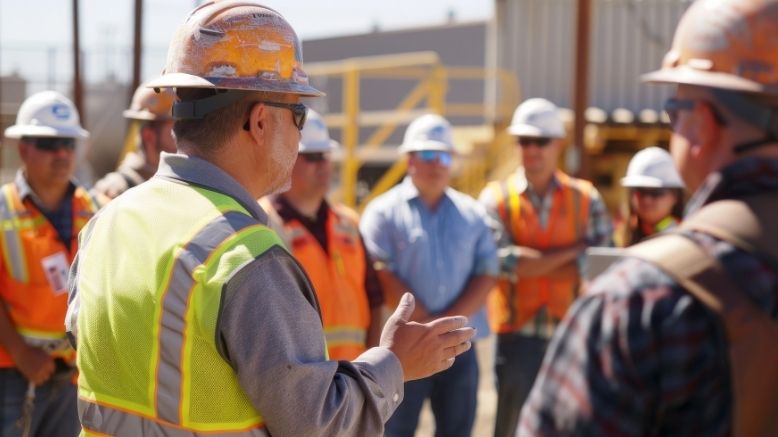— 5 min read
Interconnected Touchpoints: The 4-legged Stool for Managing Data Sharing


Last Updated Nov 11, 2025

Rob Sloyer
Vice President, Innovation & Strategic Services
Rob has been working in the South Florida Construction industry since 2001, starting out as a field engineer, APM, and then Project Manager before moving into a BIM, Technology and Operational Excellence role in 2009. After transitioning back to a PM role for a few years, Rob began working at KAST in 2015 as the Director of Technical Services, and is now Vice President of Innovation & Strategic Services. The KAST Strategic Services Department believes in Putting the Project First and eliminating pain points for customers and KAST employees through training, technology implementation, BIM/VDC, trade Coordination, Procore, and other services. Rob attended the University of Florida, earning a BA in Architecture before moving on to the Building Construction graduate program.

Diane McCormick
Writer
49 articles
Diane McCormick is a freelance journalist covering construction, packaging, manufacturing, natural gas distribution, and waste oil recycling. A proud resident of Harrisburg, PA, Diane is well-versed in several types of digital and print media. Recognized as one of the premier voices in her region, she was recognized as the Keystone Media Freelance Journalist of the Year in 2022 and again in 2023.
Last Updated Nov 11, 2025

Data is an incredibly powerful tool in construction — but the more data being produced and collected, the more room there is for errors.
A four-legged stool approach can minimize data-entry and data-analysis mistakes while maximizing efficiencies. Each leg represents an entry point where every piece of data should find a home, whether it’s in office management and communications, enterprise resource planning (ERP), project management, or document storage.
This article examines how each leg supports operations, the advantages of interconnectedness, and the keys to planning for strategic growth.
Table of contents
The 4 Legs of the Stool
Depending on the size of the business, a communication system can have many legs, but four is a good place to start for midsized businesses seeking scale and growth.
Categorizing every data point collected into one of these four business functions prevents them from spiraling into the unknown.
Office Management and Communications
Office management constitutes the central nervous system of any business. The ability to communicate via all channels keeps field and office functions in sync with developments and findings that impact project quality, scope, and budget.
ERP
Budgets change and costs are incurred in a daily ebb and flow, directly impacting the decisions made by accounting and project management. Connecting the two teams keeps costs contained, allows real-time cost-projection adjustments, and maintains a timely system of accounts payable and receivable.
Project Management
Project management software’s power to develop functional, reliable BIM models and digital twins relies on a steady stream of information from all corners of the company. Opening files from office management, incorporating drawings from document storage, and integrating costs from ERP are essential to models that keep the project on track, on budget, and up to quality expectations.
Document Storage and Management
Contracts, drawings, site diaries, meeting notes, and reams of other materials formulate the backbone of construction operations. Moving them from file folders into living documents such as BIM saves time and money by enhancing clash detection, dispute resolution, and precision installations.
The Advantages of a 4-legged Stool
In construction, the four legs of the stool provide a structure for containment and sharing of information essential to the progress of projects and companies.
Proper storage makes data retrievable and actionable across divisions, delivering these advantages that feed continuous cycles of improvement and growth.
Visible Entry Points
A tech stack that is interconnected, but also shaped into identifiable sectors offers distinct choices for shuttling data to the right place.
Real-time Updates
Until recently, team leaders had to wait for updates that might arrive daily, weekly, or monthly. Interconnectedness promotes a flow of real-time updates, for up-to-the-minute views into costs, budgets, progress, and deliveries.
Cost Savings
When the four legs of the stool are established properly and working in balance, the company spends less on internal or external tech support. No one has to be called to close a gap that hampers the distribution of information.
Extra Efficiency
Even in the digital age, construction companies rely on human intervention to move data from one screen or system to another. These double and triple entries are error-prone, time-consuming, and costly. Interconnected systems use application programming interfaces (APIs) to bridge the gaps and automatically distribute information among systems.
Fewer Log-ins
Field team members don’t have time to log in to every piece of software. Logical interconnections create access without separate logins for key functions. For instance, a PM or superintendent constantly on the project management software can access ERP budget data and real-time cost information — a regular need — without losing focus or jumping between systems.
Few log-ins allows everybody to stay working where they’re comfortable while sharing the data that is important to be shared between the two systems.

Rob Sloyer
Vice President, Innovation & Strategic Services
KAST Construction
Keeping the Stool in Balance
Through careful management, interconnected data stays powerful, fresh, and positioned to align operational efficiencies and risk mitigation with strategic goals. Higher-order functionality emerges from attention to essential tasks and functions.
It begins with interoperability. Apply the functions of popular construction-specific or -adapted software to move information with minimal steps. Automatically reshape meeting notes into emails, develop attendee lists for meeting invites, or push documents from a content collaboration system for subcontractors into BIM for superintendents to check progress in the field.
While speed is essential, real-time information carries a flip side – the danger of overreacting or responding too quickly. Spur-of-the-moment decisions based on a blip can miss the big picture, and real-time but erroneous information can trigger misguided decisions. Instead, develop a cadence for spotting trends.
You need to see it evolve over time and chase trends, not chase individual month-over-month numbers.
Rob Sloyer
Vice President, Innovation & Strategic Services
KAST Construction
Creating interconnections offers the opportunity to elevate operational staff into construction technologists.
As construction-specific software evolves, the IT position of the past — someone managing the server — may not have the operational expertise needed to manage construction business systems. Construction technologists understand the industry and the company’s internal needs, harnessing the power of technology to develop field teams to their maximum capabilities.
The same thinking applies to choosing tech partners. The ones that come from construction don’t need training on the inner workings of the industry, for accelerated implementation of, and ROI from, the technology purchased to resolve major pain points.
As long as I can get into one of the four corners of the equation, we can start using the data in other places.
Rob Sloyer
Vice President, Innovation & Strategic Services
KAST Construction
When buying new tech tools, make sure they can connect to one of the legs of the stool. Also, probe into the details of integration. How does it work? What does it do? Can it be customized with APIs if it doesn’t inherently connect? Find out how the integrations function, which data is used, and what’s doing the pushing and pulling.
Free AI in Construction Course with Hugh Seaton
Start learning today with industry expert Hugh Seaton and discover how AI can boost efficiency, reduce risk, and transform your projects.

Expanding Reach, Adding Legs
As a construction company grows, four legs might not be enough. Additional legs can be added as new functions are integrated or redistributed.
But beware: Like a stool, the more legs you add, the harder it is to balance.
Keeping systems in balance as they grow demands strategy and customization. With carefully designed containment and synchronization, interconnected information sharing will continue to drive operational efficiencies and risk mitigation in all aspects of every project.
Was this article helpful?
Thank you for your submission.
0%
0%
You voted that this article was . Was this a mistake? If so, change your vote
Scroll less, learn more about construction.
Subscribe to The Blueprint, Procore’s construction newsletter, to get content from industry experts delivered straight to your inbox.
By clicking this button, you agree to our Privacy Notice and Terms of Service.
Thank you!
You’re signed up to receive The Blueprint newsletter from Procore. You can unsubscribe at any time.
Categories:
Written by

Rob Sloyer
Vice President, Innovation & Strategic Services | KAST Construction
Rob has been working in the South Florida Construction industry since 2001, starting out as a field engineer, APM, and then Project Manager before moving into a BIM, Technology and Operational Excellence role in 2009. After transitioning back to a PM role for a few years, Rob began working at KAST in 2015 as the Director of Technical Services, and is now Vice President of Innovation & Strategic Services. The KAST Strategic Services Department believes in Putting the Project First and eliminating pain points for customers and KAST employees through training, technology implementation, BIM/VDC, trade Coordination, Procore, and other services. Rob attended the University of Florida, earning a BA in Architecture before moving on to the Building Construction graduate program.
View profile
Diane McCormick
Writer | Procore Technologies
49 articles
Diane McCormick is a freelance journalist covering construction, packaging, manufacturing, natural gas distribution, and waste oil recycling. A proud resident of Harrisburg, PA, Diane is well-versed in several types of digital and print media. Recognized as one of the premier voices in her region, she was recognized as the Keystone Media Freelance Journalist of the Year in 2022 and again in 2023.
View profileExplore more helpful resources

Defending Against Financial & Legal Risks on Megaprojects
The construction industry has seen marked growth in megaprojects. Some experts classify any project over $500 million as a megaproject, while others argue that the build needs to be $1...

Unlocking Project Intelligence: Moving from Raw Data to Actionable Insights
The construction industry faces a wide range of challenges, from ongoing labor shortages to frequent cost overruns. But some the biggest hurdles all stem from unpredictability. The general contractors (GCs)...

Who is accountable for innovation in construction?
Everyone says construction needs to innovate—but no one agrees on who’s actually responsible for making it happen. Is it the owner? The builders? The tech vendor? Or is innovation everyone’s...

Integrated Project Delivery in Practice: A Framework for Collaboration
On construction projects, traditional delivery methods put different stakeholders in their own silos. While the design team feeds drawings and specifications to the general contractor (GC), the GC’s expertise in...
Free Tools
Calculators
Use our calculators to estimate the cost of construction materials for your next project.
Templates
Find a template to help you with your construction project tasks.
Material Price Tracker
Get the latest U.S. retail prices and view historical trends for common building materials.
Glossary
Explore key terms and phrases used in the industry.
